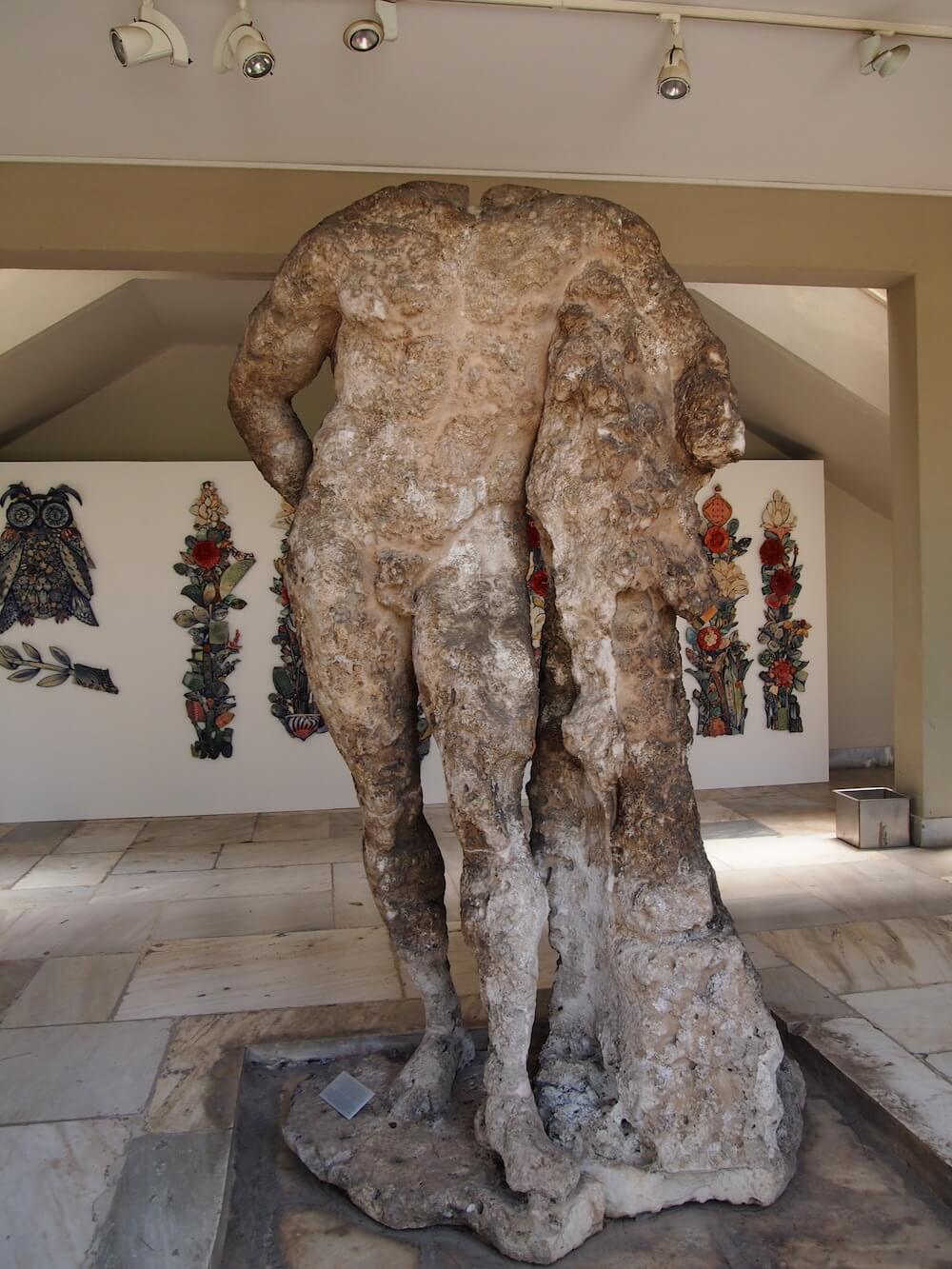
The Maritime Transport of Sculptures in the Ancient Mediterranean
May 2023 | Vol. 11.5
By Katherina Velentza
From the 16th century onwards, hundreds of Greek and Roman sculptures have been discovered in the Mediterranean Sea, both from shipwrecks and isolated finds. This material constitutes some of the strongest evidence for studying the maritime transport of sculpture in antiquity. Yet, despite the large number of underwater sculptural finds, their early discovery and long period of study, most researchers of the ancient Mediterranean have so far analysed those artefacts primarily from an art historical perspective. The interpretation of their maritime transportation has largely remained conjectural, due to the incomplete recording and the remoteness of their underwater findspots.

Figure 1: Stone sculpture found in the sea off Cape Xi, in Kefalonia, Greece. Now in the Building of Pasha at the castle of Pylos. ©Katerina Velentza.
To rectify this situation, I undertook a project to retrieve data about the underwater archaeological context of ancient sculptures with the aim to interpret anew where, when, why and how sculptures were transported by sea in the ancient Mediterranean world. For that purpose, I compiled a database of 110 entries recording any known incident of Greek or Roman sculptures found on the Mediterranean seabed. For each database entry I recorded: the country and date of discovery; any dating information available for the underwater archaeological deposit; the number, material, type and date of the retrieved sculptures; any evidence for preserved hull remains, or packaging of the cargo; as well as the presence of amphorae, coins, architectural pieces, domestic furnishing, pottery, glassware, ingots, scrap metal, skeletal remains or other objects found on the seabed with the sculptures.
Based on the geographical distribution of the underwater incidents (Fig. 2), we can see right away that sculptures were transported by sea all around the ancient Mediterranean world. The evidence, however, is uneven. Modern day factors, such as historical circumstances, local politics, development of large-scale fishing, recreational underwater activities, as well as the availability of provisions for the documentation and protection of underwater cultural heritage, have influenced the preservation of evidence in specific regions more than others. Nonetheless, overall the geographical distribution of underwater sites with sculptures proves clearly that the maritime transport of sculptures in the ancient Mediterranean was widespread and not restricted between exclusive regions or geographical areas.
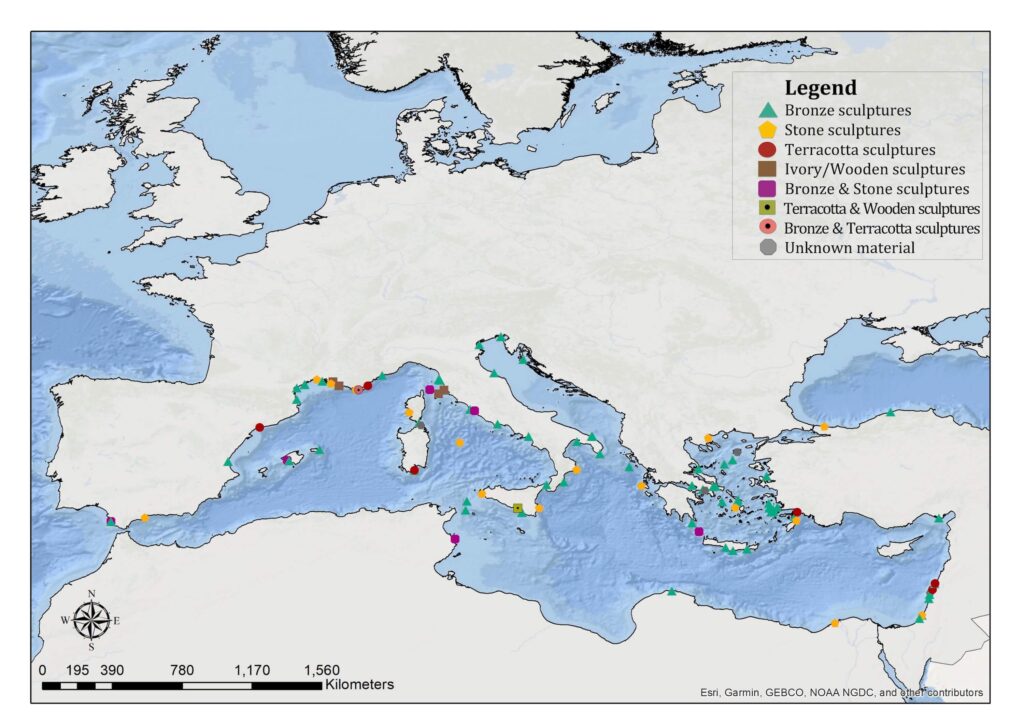
Figure 2: Map showing the geographical distribution of underwater sculptural finds in the Mediterranean region. ©Katerina Velentza.
The information gathered in the database also established a chronology for the time periods of Graeco-Roman antiquity when sculptures were transported by sea. Of the recorded incidents, only 42% of sculptural discoveries preserved information that allowed dating of their underwater deposition. This dating information showed that sculptures were transported by sea from the 7th/6th century BC to the 7th century AD.
Above all, the systematic study of the dataset has made it possible to identify distinct reasons for and patterns of maritime transport of sculptures in the ancient Mediterranean world. The first recognisable reason of sculptural transport has been the movement of small-scale sculptures as shipboard items or personal belongings. This type of movement was not commercial. The sculptures belonged to the sailors and passengers or were part of a shrine on board the ship. The chronological span of this transport ranges from as early as the 7th century BC up to the 2nd century AD, even though later examples of this activity might be recognised in the future.
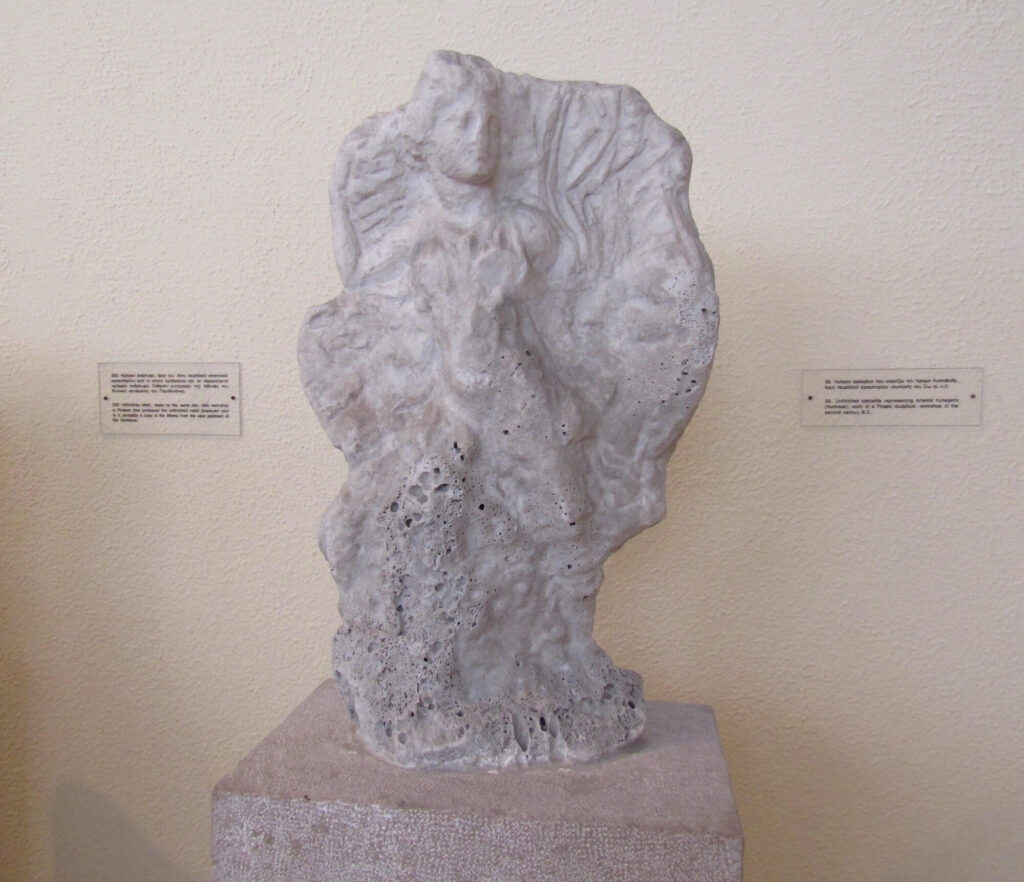
Figure 3: Unfinished stone sculpture found under water at the harbour of Piraeus, Athens, Greece. Now in the Archaeological Museum of Piraeus. ©Katerina Velentza.
The second pattern is the maritime transport of stone sculptures as part of wider stone cargo, a trading activity developed widely in the Mediterranean world during the period of the Roman empire. The shipwrecks recognised in this pattern are found in both the western and eastern Mediterranean, as well as in the Black Sea. These underwater sites preserve stone blocks, architectural members, and marble sculptures, some of them in an unfinished stage (Fig. 3), shipped for trading purposes from the 1st century BC to the 3rd century AD.
The third pattern detected is the trade of sculptures with other luxury objects, which has been archaeologically documented only for the last two centuries BC and in underwater sites off the coasts of Greece, Italy and northern Africa. The Antikythera (Fig. 4) and Mahdia shipwrecks, dated both in the late 2nd or early 1st century BC, are the two most notable examples.

Figure 4: Marble statue of Herakles from the Antikythera shipwreck, Greece. Now in the National Archaeological Museum of Athens. ©Katerina Velentza.
The fourth identified pattern for the maritime transport of sculptures comprises a less well-documented reason, which is the trade of bronze sculptures (Fig. 5) and other metals as scrap to be recycled. This maritime activity was connected to a wider circulation of metalware and the redistribution of non-functional metal objects with the intention to create raw material. It can be seen in the archaeological record from at least the Hellenistic period to the Late Antique period in Spain, Italy, Greece and Israel.
The fifth pattern of sculptural transport is related to underwater deposits with only terracotta sculptural pieces. These sites, located mostly around Italy and along the Levantine coast, must have been the result of the maritime transport of solely terracotta sculptures for either trade or religious purposes, and are dated between the 5th and 2nd centuries BC. The poor recording of the respective underwater archaeological contexts, though, did not permitted a better documentation of this activity.

Figure 5: Bronze figurine of a male figure from the Favaritx shipwreck, Menorca, Spain. This small sculpture was transported with other metal objects as scrap to be recycled. Currently in the Museum of Menorca (Inv. No. 21567). ©Katerina Velentza.
Finally, in the researched dataset, there are several sites that do not fit in any of the reasons and patterns of transport described above. These are mostly out-of-context underwater sculptural discoveries, which lack adequate archaeological information, such as the dancing satyr of Mazara del Vallo (Fig. 6). Some others, though, were well-identified shipwrecks with sculptures from preserved archaeological contexts, but with unique features, distinct chronology and geographical location, which did not permit a straightforward identification of a transport pattern. One of these examples is the Porticello shipwreck (Fig. 7). Re-examination of its material in combination with ancient literary testimony suggests that this late fifth- or early fourth-century BC ship could have been carrying bronze sculptural pieces for three possible reasons: as scrap to be recycled; as sculptural dedications commissioned and sent to be dedicated in a specific sanctuary or city overseas; or simply as traded sculptural products sent to be sold and redistributed in a different region and market. This interpretation adds two more reasons in the maritime movement of sculptures: (1) the shipping of sculptures for religious dedications, which has been known to classical archaeologists so far only from terrestrial archaeological evidence or ancient textual references; and (2) the maritime transport of sculptures for purely trading purposes, a commercial transportation presumed already but without (until now) identified underwater archaeological evidence.

Figure 6: The bronze statue of the dancing satyr, displayed in the Museo del Satiro Danzante in Mazara del Vallo, Sicily. This large-scale sculpture was found in the sea off Sicily as an isolated find, out of archaeological context. ©Katerina Velentza.
The shipping of sculptures in all the above patterns involved the movement of a heterogeneous, mixed cargo, picked up and redistributed by merchant ships that stopped in several ports and harbours across their trading route. The agents involved in these commercial activities, such as the individuals who organised the shipping and the logistical details, were not possible to identify just from the study of the underwater archaeological record. However, references in the ancient sources, such as Cicero asking to send sculptures from Athens to Italy with “Lentulus’ ship” (Cicero, Letters to Atticus 1.8.2) and Philostratus’ ship captain transporting sculptures to Asia Minor (Philostratus, Vita Apollonii 5.20), suggest that regular sea merchants and ship contractors must have been involved in this maritime transport.

Figure 7: Bronze statue head of a bearded youth from the Porticello shipwreck. Currently in the National Archaeological Museum of Reggio Calabria, Italy. ©Katerina Velentza.
With the current state of most underwater archaeological sites, it has not been feasible to discern clearly detailed shipping routes, precise transport networks, or specific shipping orders and sculptural exports from individual cities or workshops. Overall, though, this new research shows that the maritime transport of sculptures was a normal commercial activity that took place with the use of regular means of mercantile transport existing in the ancient Mediterranean world. Its preparation and execution must have been a long process that would have involved careful planning and probably several months or weeks to complete.
Katerina Velentza is a Postdoctoral Researcher and Kone Foundation Fellow at the University of Helsinki. Her book, The Maritime Transport of Sculptures in the Ancient Mediterranean, was recently published by Archaeopress.
How to cite this article
Velentza, K. 2023. “The Maritime Transport of Sculptures in the Ancient Mediterranean.” The Ancient Near East Today 11.5. Accessed at: https://anetoday.org/velentza-maritime-transport-sculptures/.
Want to learn more?
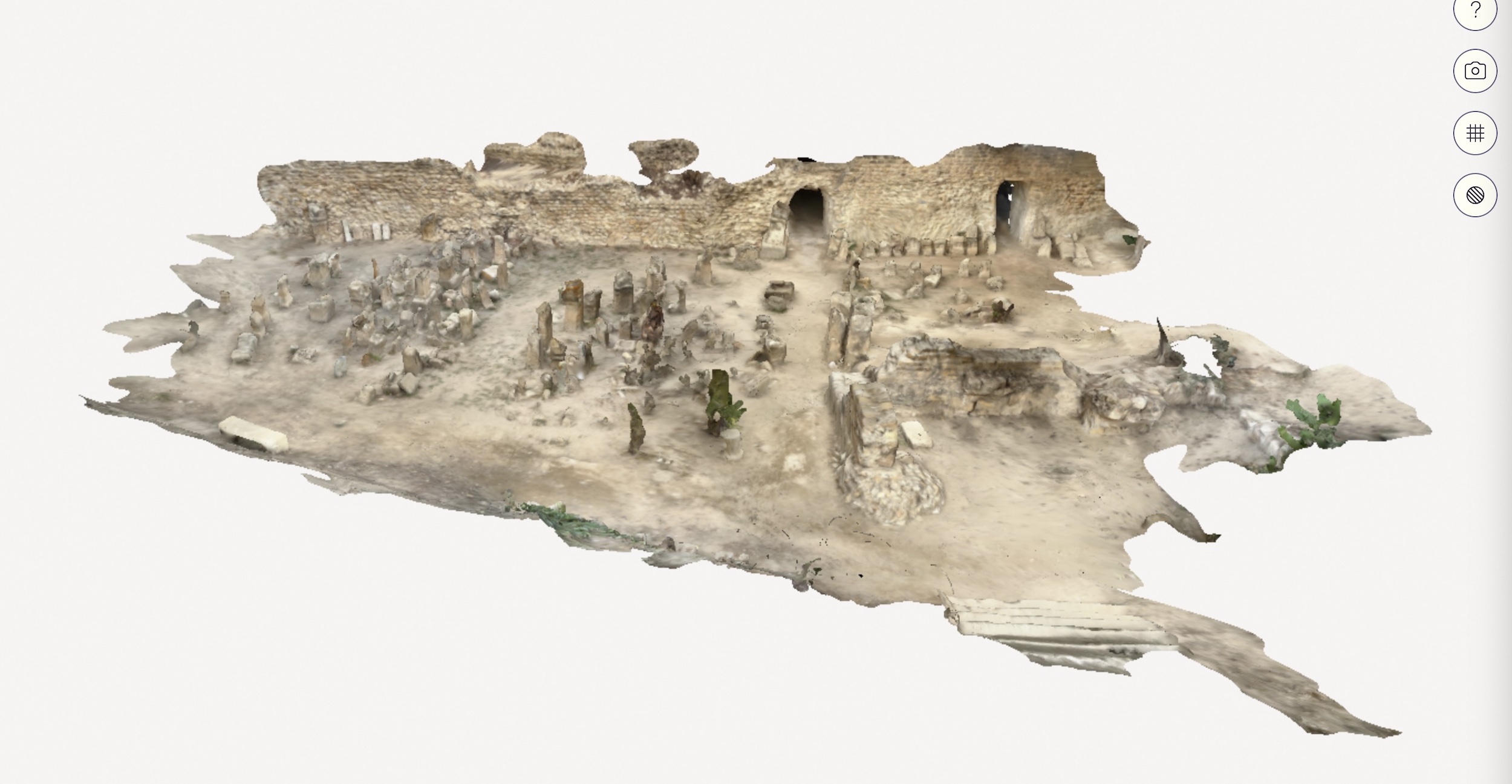
Putting Carthaginian Stelae Back Into Context: The ASOR Punic Project Digital Initiative

Cyprus and Ugarit: A Tale of Two Late Bronze Age Mercantile Polities
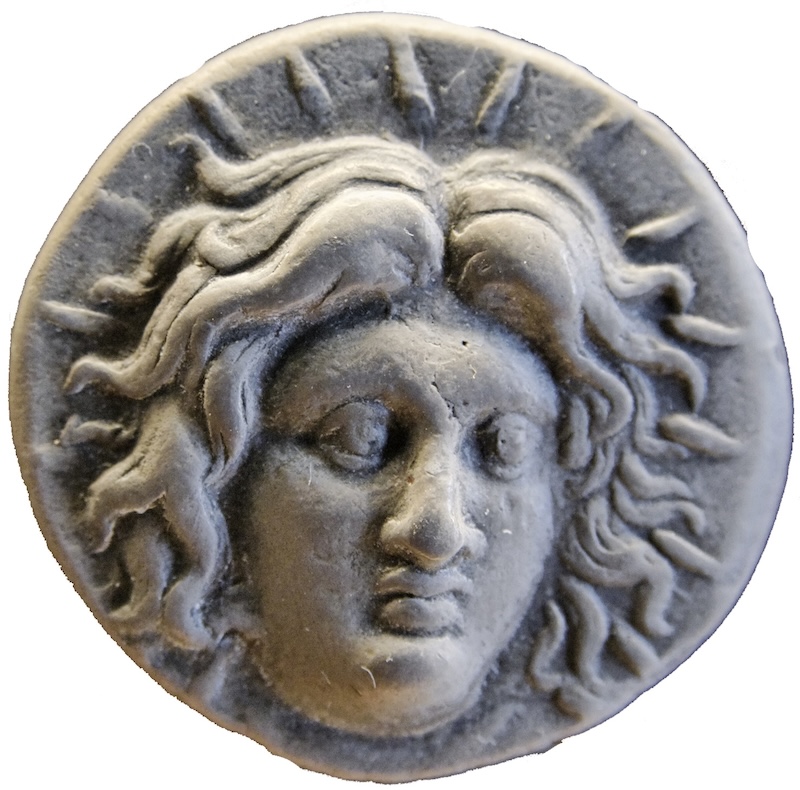


Post a comment